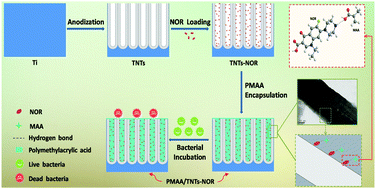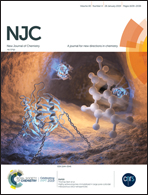Polymethacrylic acid encapsulated TiO2 nanotubes for sustained drug release and enhanced antibacterial activities†
Abstract
Bacterial infection and insufficient osseointegration of titanium and its alloys take primary responsibility for the failure of orthopedic implants. In this study, in order to improve antibacterial and osteogenic properties of titanium, homogeneous TiO2 nanotubes having diameters of about 114 nm were fabricated through electrochemical anodization for loading of antibacterial drug, norfloxacin. Then, polymethacrylic acid encapsulated TiO2 nanotubes were obtained by a free radical polymerization for sustained and controllable release of norfloxacin. The surfaces of different samples were characterized by scanning electron microscopy (SEM), transmission electron microscopy (TEM), Fourier transform infrared spectroscopy (FTIR), X-ray powder diffractometry (XRD), X-ray photoelectron spectroscopy (XPS), and water contact angle measurements. The polymer encapsulated TiO2 nanotubes showed better sustained release of drug (more than 168 h) and predictably reduced burst release (34.4%). In addition, a series of antibacterial assays showed that the material had superior antibacterial activity against both Gram-positive Staphylococcus aureus (S. aureus) and Gram-negative Escherichia coli (E. coli) and also significant short- and long-term (more than 5 days) antibacterial effect. Furthermore, in vitro biocompatibility evaluation including cell viability and immunofluorescence staining measurements confirmed that this polymer encapsulated TiO2 nanotubes had excellent biocompatibility. Hence, the resultant material can be considered as a promising biomaterial for a long-lasting effect on reducing bacterial infection and enhancing bone osseointegration.



 Please wait while we load your content...
Please wait while we load your content...